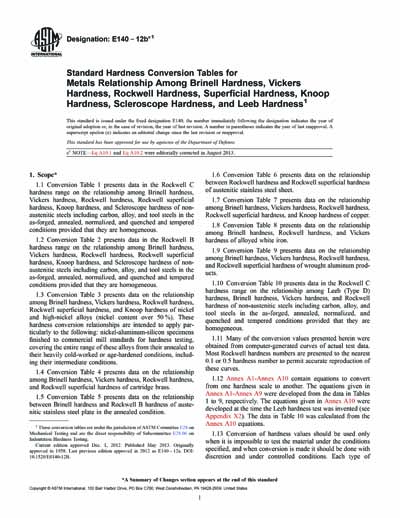Historical
ASTM E140-12be1
Standard Hardness Conversion Tables for Metals Relationship Among Brinell Hardness, Vickers Hardness, Rockwell Hardness, Superficial Hardness, Knoop Hardness, Scleroscope Hardness, and Leeb Hardness
1.1 Conversion Table 1 presents data in the Rockwell C hardness range on the relationship among Brinell hardness, Vickers hardness, Rockwell hardness, Rockwell superficial hardness, Knoop hardness, and Scleroscope hardness of non-austenitic steels including carbon, alloy, and tool steels in the as-forged, annealed, normalized, and quenched and tempered conditions provided that they are homogeneous.
1.2 Conversion Table 2 presents data in the Rockwell B hardness range on the relationship among Brinell hardness, Vickers hardness, Rockwell hardness, Rockwell superficial hardness, Knoop hardness, and Scleroscope hardness of non-austenitic steels including carbon, alloy, and tool steels in the as-forged, annealed, normalized, and quenched and tempered conditions provided that they are homogeneous.
1.3 Conversion Table 3 presents data on the relationship among Brinell hardness, Vickers hardness, Rockwell hardness, Rockwell superficial hardness, and Knoop hardness of nickel and high-nickel alloys (nickel content over 50 %). These hardness conversion relationships are intended to apply particularly to the following: nickel-aluminum-silicon specimens finished to commercial mill standards for hardness testing, covering the entire range of these alloys from their annealed to their heavily cold-worked or age-hardened conditions, including their intermediate conditions.
1.4 Conversion Table 4 presents data on the relationship among Brinell hardness, Vickers hardness, Rockwell hardness, and Rockwell superficial hardness of cartridge brass.
1.5 Conversion Table 5 presents data on the relationship between Brinell hardness and Rockwell B hardness of austenitic stainless steel plate in the annealed condition.
1.6 Conversion Table 6 presents data on the relationship between Rockwell hardness and Rockwell superficial hardness of austenitic stainless steel sheet.
1.7 Conversion Table 7 presents data on the relationship among Brinell hardness, Vickers hardness, Rockwell hardness, Rockwell superficial hardness, and Knoop hardness of copper.
1.8 Conversion Table 8 presents data on the relationship among Brinell hardness, Rockwell hardness, and Vickers hardness of alloyed white iron.
1.9 Conversion Table 9 presents data on the relationship among Brinell hardness, Vickers hardness, Rockwell hardness, and Rockwell superficial hardness of wrought aluminum products.
1.10 Conversion Table 10 presents data in the Rockwell C hardness range on the relationship among Leeb (Type D) hardness, Brinell hardness, Vickers hardness, and Rockwell hardness of non-austenitic steels including carbon, alloy, and tool steels in the as-forged, annealed, normalized, and quenched and tempered conditions provided that they are homogeneous.
Content Provider
ASTM International [astm]






